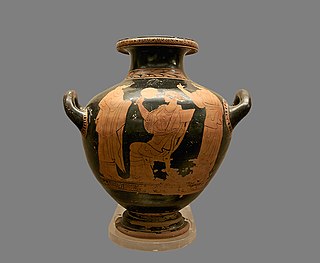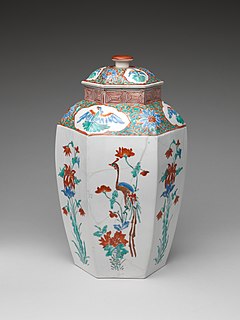 W
WAn amphora is a type of container with a pointed bottom and characteristic shape and size which fit tightly against each other in storage rooms and packages, tied together with rope and delivered by land or sea. The size and shape have been determined from at least as early as the Neolithic Period. Amphorae were used in vast numbers for the transport and storage of various products, both liquid and dry, but mostly for wine. They are most often ceramic, but examples in metals and other materials have been found. Versions of the amphorae were one of many shapes used in Ancient Greek vase painting.
 W
WIn modern usage, an aquamanile is a ewer or jug-type vessel in the form of one or more animal or human figures. It usually contained water for the washing of hands over a basin, which was part of both upper-class meals and the Christian Eucharist. Historically the term was sometimes used for any basin or ewer so used, regardless of shape. Most surviving examples are in metal, typically copper alloys, as pottery versions have rarely survived.
 W
WA barrel or cask is a hollow cylindrical container with a bulging center, longer than it is wide. They are traditionally made of wooden staves and bound by wood or metal hoops. The word vat is often used for large containers for liquids, usually alcoholic beverages; a small barrel or cask, typically with capacity of not more than ten gallons, is known as a keg.
 W
WA bridge-spouted vessel is a particular design of ewer originating in antiquity; there is typically a connecting element between the spout and filling aperture, and the spout is a completely independent aperture from the usually smaller central fill opening. Early incidences of the bridge-spouted vessel are found in Persia in the early Iron Age and on Crete. This type of vessel typically appears in the Bronze Age or early Iron Age. A very early example of a bridge-spouted bowl has been recovered at the ancient palace of Phaistos on Crete, dating to the Bronze Age.
 W
WThe hydria is a form of Greek pottery that existed between the Late Geometric Period and the Hellenistic period. The etymology of the word hydria was first noted when it was stamped on a hydria itself, its direct translation meaning ‘jug’.
 W
WThe hydria is a form of Greek pottery that existed between the Late Geometric Period and the Hellenistic period. The etymology of the word hydria was first noted when it was stamped on a hydria itself, its direct translation meaning ‘jug’.
 W
WA jar is a rigid, cylindrical or slightly conical container, typically made of glass, ceramic, or plastic, with a wide mouth or opening that can be closed with a lid, screw cap, lug cap, cork stopper, roll-on cap, crimp-on cap, press-on cap, plastic shrink, heat sealed lidding film, an inner seal, a Tamper-evident band, or other suitable means.
 W
WAn oenochoe, also spelled oinochoe, is a wine jug and a key form of ancient Greek pottery. Intermediate between a pithos or amphora, and individual cups or bowls, it held fluid for several persons temporarily until it could be poured. The term oinos appears in Mycenaean Greek, but not the compound. The characteristic form was popular throughout the Bronze Age, especially at prehistoric Troy. In classical times for the most part the term oinochoe implied the distribution of wine. As the word began to diversify in meaning, the shape became a more important identifier than the word. The oinochoe could pour any fluid, not just wine. The English word, pitcher, is perhaps the closest in function.
 W
WA Paan Dan or Faandan is a container for storing Paan used in South Asian households. It also stores other ingredients such as zarda, supari, kattha, choona, clove, cardamom (elachi), etc. and other accessories. A Paan dan is a silverware, and it was used mostly storing betel leaf, betel seeds and most other spices for making a Paan. Made of metal, the Paan dan is often perforated and has several compartments for storing the individual ingredients for making Paan.
 W
WIn American English, a pitcher is a container with a spout used for storing and pouring liquids. In English-speaking countries outside North America, a jug is any container with a handle and a mouth and spout for liquid — American "pitchers" will be called jugs elsewhere. Generally a pitcher also has a handle, which makes pouring easier. A ewer is an older word for pitchers or jugs of any type, though tending to be used for a vase-shaped pitcher, often decorated, with a base and a flaring spout. The word is now unusual in informal English describing ordinary domestic vessels. A notable ewer is the America's Cup, which is awarded to the winning team of the America's Cup sailing regatta match.
 W
WA stirrup jar is a style of pottery vessel, which flourished during the Late Bronze Age after a probable origin at the end of the Middle Bronze Age, probably on Crete. H.W. Haskell, a theorist of the later 20th century, proposed that it began as a one-time invention on Crete, to accomplish more efficient, less wasteful pouring of expensive fluids, to take the place of various amphorae used for the purposes. From there it passed to the Cyclades.